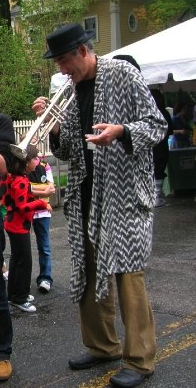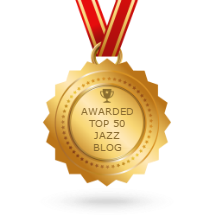 A previous post dealt with one stylistic element of jazz: vibrato. I said I would next concentrate on vibrato in jazz vocals, but before we get there, let's set the foundation by looking at some music that was recorded in the pre-jazz era.
A previous post dealt with one stylistic element of jazz: vibrato. I said I would next concentrate on vibrato in jazz vocals, but before we get there, let's set the foundation by looking at some music that was recorded in the pre-jazz era.Jazz qua jazz wasn't recorded until the late teens and blues until the early 20's, but beginning in the 1890's, some of the styles that were grist for the jazz mill did find their way onto cylinders and discs: string and brass band music, "parlor" songs, ragtime, ethnic, vaudeville, minstrel and concert hall music. It's a partial record, but we'll try to get a sense of where vibrato and other expressive elements used in vocal jazz came from by listening to some influential vocalists who recorded during the first couple of decades of the twentieth century. Yes, instrumentalists always influence vocalists and vice versa, but we'll leave that tangle for future posts. Also, although it's clear that recordings of music from places like the Caribbean and South/Central America had an influence on jazz, I won't go into music with vocals targeted for foreign-language groups.
 |
| Enrico enjoys a smoke |
Many early recordings fall under the light classical/parlor music/Stephen Foster umbrella. Practitioners often came from an operatic tradition, but used vibrato with a lighter touch. Soprano Nellie Melba is a good example, as you can hear here.
 |
| The inspiration for Peach Melba |
 |
A more direct line to a jazz style can be drawn from the vocal music that was derived from minstrelsy, vaudeville, ragtime, or some combination of those. Clarice Vance is credited as developing the naturalistic, almost vibrato-free style which influenced many other popular singers. She reminds me of Blossom Dearie. Here's "Goodbye to Johnny":
Bert Williams was probably the most well-known African-American stage/vaudeville performer and recording artist from the turn of the 20th century until about 1920. Stylistically, this recording is an archaic and modern amalgam, with comedic effects, stuttering and trombone smears, with a subtle undertone of emotionality.
 |
| Last of the Red Hot Mamas |
As time took a toll on Tucker's voice, she increasingly laid on the vibrato, but she explored time in a very jazz-like way:
 |
| Billy |
 |
| Al |
Here's Murray as recorded on an Edison cylinder, probably about 1905-1910. As noted, it is a ragtime-influenced vaudeville style. Happily, it avoids the minstrel "coon" cliches that are otherwise common in recordings from that era.
Murray did make some recordings with jazz outfits, including this one, w. Jean Goldkette. It's pleasant, not laden with vibrato. His voice is more relaxed, but he does push the beat rather than lay back in a way that was becoming more the norm in jazz.
There were a bunch of transitional mid 19-teens recordings that specifically used the word "jass." The first recording that used the word jass in the title or in which the band was referred to as a jass band was recorded by the very popular duo of Arthur Collins and Byron Harlan in 1916. The singing was very like what Billy Murray had been doing-vaudeville/story-telling with "pep;" highly inflected, but with little vibrato.
The singing we heard in this post utilized a wide range of stylistic techniques, although the rhythmic influence of ragtime in popular music was pretty universal. Toward the end of this period, there was a definite movement of well-known vaudeville and minstrel performers toward "jass." To my ears, this meant a change from what might have once been a more "sincere" emotional delivery to one that was more overtly excited, raucous and rhythmically free.
Jazz personified this "roaring" style and with the recordings of the Original Dixieland jass band, it took center stage. Other, black bands in New Orleans, Chicago, New York and San Francisco were recorded, as was blues and other "race" music, giving a much more complete picture of what American culture had actually been up to.
As parlor music and light classical music diminished in popularity, so did some stylistic elements associated with that music, like intense vibrato and precise enunciation. Although these elements continued to be used in popular vocals, other, "cooler" styles emerged, as we'll hear next time, in:


3 comments:
Great survey of these artists, and great to read about some of them as artists rather than just novelties or historical curiosities. It's also really helpful to consider just how popular and therefore influential "classical" vocalists like Caruso and Melba were on all aspects of the musical scene.
Several years ago Opera News magazine (Peter Gelb's favorite!) published an article about singers such as Caruso, Melba, Ponselle, Tetrazinni, etc. and how their "excesses," including noticeable vibrato, would never fly today. Interesting survey and commentary on how in some ways contemporary tastes have become homogenized. Just wish I could find it!
Thanks, Andrew. We bring so many filters and biases when we listen to this music that it's difficult to bring fresh ears. As in every era, there's chaff that justifiably passes quickly and other work that deserves our attention.
If you find the article, let me know.
Thank you. I appreciate your positive feedback and am gratified if I have helped you in any way to pursue your own creative goals.
Post a Comment